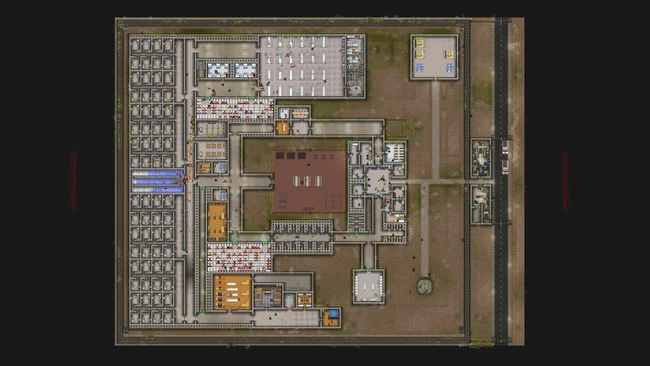Table of Contents Show
Prison Architect Dealing with Contraband
Contraband is a perpetual issue of prison security, affecting all aspects of prison life. Reducing contraband is one of the central mechanics of the game, and many tools in the game are designed either primarily or secondarily to help you to tackle contraband.
Many architects find contraband to be one of the most frustrating and challenging aspects of gameplay. There are many reasons for this. Firstly, the reasons why prisoners can access contraband are many. Secondly, the ways of getting contraband out of prisoner’s hands are many, and they all come with some disadvantages compared to the others. Many architects find it difficult to develop a comprehensive contraband strategy for their prison.
This guide aims to help you to defeat contraband. You will never defeat contraband for good – you must continually adapt to new challenges and optimise your particular prison. The benefits of reducing contraband demand and supply can be enormous, from reduced prisoner violence, reduced escapes and escape attempts, reduced drug overdoses, improved prisoner health, and more cooperative prisoners (perhaps who will work more and have a higher chance of early parole, earning you more money).
Reducing demand
Every one of the 4 main classifications of contraband are wanted by prisoners for particular reasons. You can target these reasons in a primary way to reduce the need so that, even if access is high, prisoners may feel no need to access the contraband. You will never get this to 0, and you cannot pander to every prisoner need whilst also maintaining adequate punishment and security, but consider these aspects. For assessing the needs of prisoners below, use the “Prisoner Needs” tab and focus on the relevant metrics.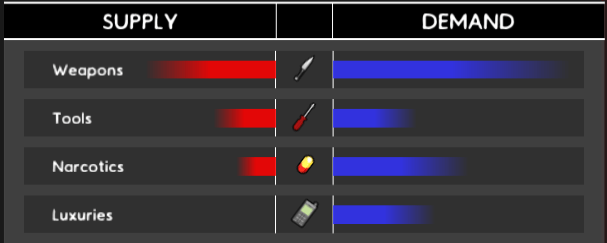
- Improve your prison safety. If prisoners feel safe, then they will feel less need to arm themselves with “Weapons” and “Tools” to defend themselves. Improving safety can be as simple as keeping your dog handlers and armed guards further away from prison wings, having regular guard patrols of areas, punishing violent offenders, and meeting all other prisoner needs to reduce their proclivity for violence.
- Improve the prisoner’s sense of freedom. If prisoners feel somewhat free, then they will feel less need to gather tools and other items that may be used in escape attempts such as tunelling. You can never fully satisfy this need (after all, you are running a prison), but you can improve the feeling of freedom with more free time in the “Schedule”, more “Common Room” and “Yard” access (and higher quality for both of these rooms), and sufficient visitation rights.
- Treat drug addiction and alcohol abuse promptly. You can know how many of your inmates are addicted to drugs quite quickly by how many want to join the “Alcoholics Group Therapy” and “Pharmacological Treatment of Drug Addiction” programmes in “Programmes”. Even if people are not cured, participation in these programmes reduces the need for drugs. This will reduce the need for prisoners to access these illicitly.
- Provide some luxuries to prisoners. If prisoners feel that they have good access to luxuries (which you can assess globally in the “Prisoner Needs” tab), then they will be less likely to try to steal these. A good way to provide luxuries is with the “Shop”, which every prison with working prisoners should include to deal with this need.
Reducing overall supply
Reducing supply can be generally prophylactic – this being to target the most general sources of contraband such as entering goods, and to target the most important areas for use of contraband such as cell blocks. Metal detectors are most useful against weapons and tools, and dog handlers are most useful against drugs and luxuries.
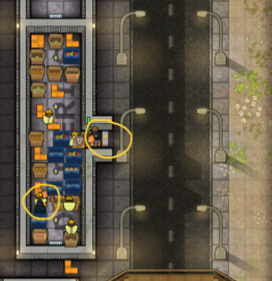
- Screen entering people and supplies. All entering supplies should be screened with a metal detector, which will detect most weapons and tools. It is also advisable to screen entering supplies multiple times (for example, perhaps have a small building for deliveries with only 1 entrance and a metal detector here, so that all entering supplies are screened twice). A dog patrol in the deliveries area can be helpful. With the “Island Bound” DLC, you ma also use scanner machines, which is advisable (albeit very resource-intensive on your guards).
- Ensure that inmates cannot be within 10 squares of the perimeter wall. Items can be thrown over the perimeter wall. The best way to keep inmates away from the wall is for buildings to face inwards, and to add doors and fences between nearby buildings to cordon off spaces near the perimeter wall. You will not need to patrol any areas for thrown contraband if you employ this strategy.
- Ensure that all inmates are searched on arrival. This should be done automatically, but having a reception makes this easier. Prisoners may be searched in their cells if you do not have a reception, or they may not be searched at all.
- Patrol outer echelons of the prison (near the wall(s)), particularly with dog handlers. This will allow for the detection of tunnels. Whilst most tunnels dug by prisoners will be for means of escape, they may also be dug in order to create an opening hole within 10 squares of the perimeter wall in order to access thrown contraband (more-so a feature in “Escape mode” than something that happens organically).
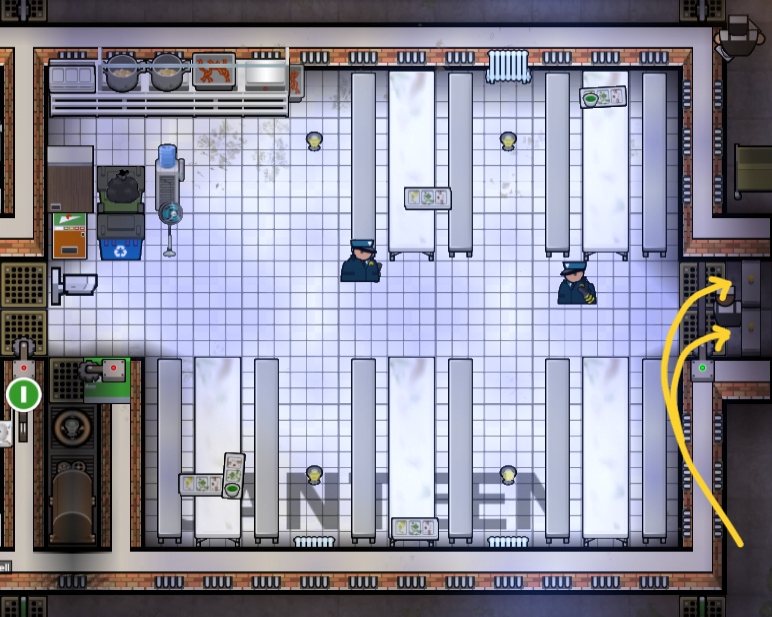
- Screen inmates with metal detectors. Weapons and tools are the most dangerous contraband, and must be eliminated everywhere in the prison. Use metal detectors at the entrances to the cell blocks and canteens, where inmates congregate and may be out of the purview of enough guards to contain violence. Conversely, having too many metal detectors may lead to inmates being searched unnecessarily (as they may go off even for inmates with no metal contraband), leading to prisoners becoming more violent.
Reducing supply from rooms
Specific rooms within your prison present a risk of contraband getting into your prisoner’s hands. Full details of the risks of particular rooms are provided elsewhere and will not be included here – you may use the “Dangers” function of “Intelligence” to learn more about what contraband is available in each room in your prison. You should take specific steps to combat this for each room.
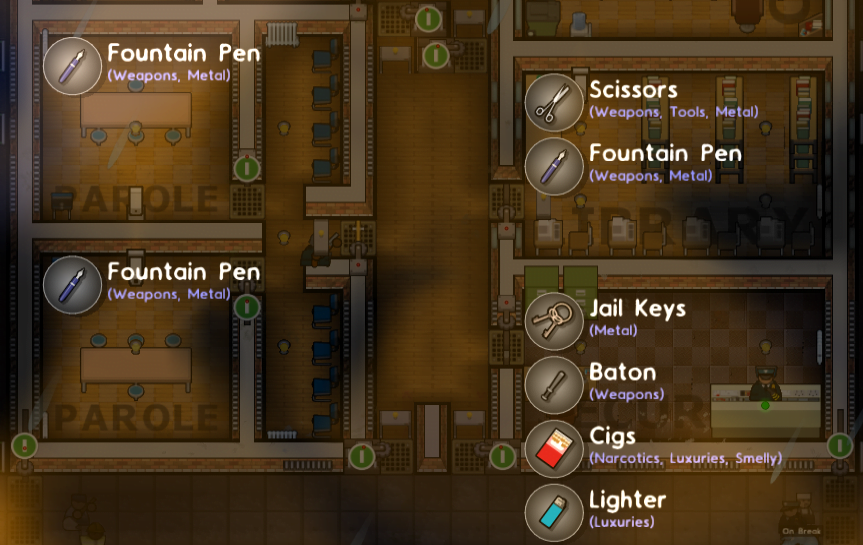
- Prevent prisoners from entering areas that they have no reason to be in. A prisoner should have no need to visit “Deliveries”, “Storage”, “Office” (at least of administrators other than the psychologist), any of the security-related rooms, and others – make these staff-only rooms, and preferably keep them further away from the main areas where prisoners have access.
- The more dangerous the contraband, the further from prisoners you keep it. Weapons should be kept furthest away (making the kitchen, the workshop, and the forestry the most dangerous rooms, as an area where prisoners may have jobs but still has dangerous weapons). Guns (from security-related rooms) and drills (from “Storage” or “Workshop”) are some of the most lethal weapons, whilst jail keys are useful for escapes – keep your security rooms behind multiple doors so that, even if a prisoner gets through some doors, they will not be able to access these items.
- Control which prisoner categories can have jobs. As previously explained, the kitchen, the workshop, and the forestry represent serious hazards. It is advisable that protective custody, maximum security, and SuperMax security are not allowed access to these areas at all. Depending on circumstances, you may wish to limit some of these areas only to minimum security. You may be aided by separating out specific kitchens or workshops for different security gradings to work in, with more staff and surveillance available for areas where higher-risk prisoners work. In general, minimum security prisoners are safe to work in these environments as long as they are under surveillance and / or a regular guard patrol.
- Use metal detectors as appropriate. Learn which rooms metal contraband can be obtained from, and make sure that prisoners are screened on entry and exit to these rooms with a metal detector. Metal detectors are very reliable, but not 100% reliable, so you will still need metal detectors for “screening” inmates generally across the prison. Bear in mind that prisoners may hold onto metal contraband so long as they stay in the room, so may use the contraband already present in a room (this is most dangerous in the kitchen and the parole rooms).
- Use dog handlers as appropriate. Particular rooms will present a significant risk, including the infirmary (for drugs), visitation (for all kinds, but only if you use table rather than booths), and cleaning cupboards (for drugs). Dogs will be able to sniff out nearly all drugs, and a reasonable amount of luxuries and other contraband.
- Bear in mind other more minor risks. Amongst these are the laundry, where prisoners may steal ropes with which to escape the prison by jumping the walls – there is almost no way to detect these, but prisoners will usually only steal them if they are already able to dig a tunnel.
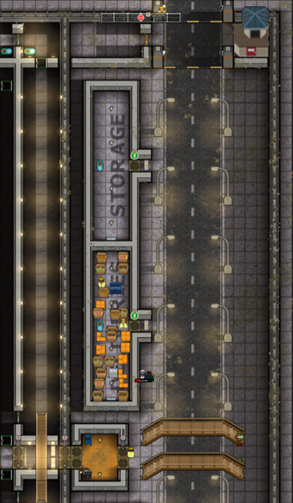
- Keep the deliveries area outside of the main prison walls so that prisoners cannot access it. It is also important to keep it indoors if possible so that your staff can keep it secure from thrown contraband.
Using intelligence – target weaknesses
“Intelligence” is almost essential if you want to improve your methods of reducing contraband. You will not gain the “Dangers” tab to understand the need for contraband and the supply of contraband. You will also not be able to get a map of where contraband has been detected and where it came from.
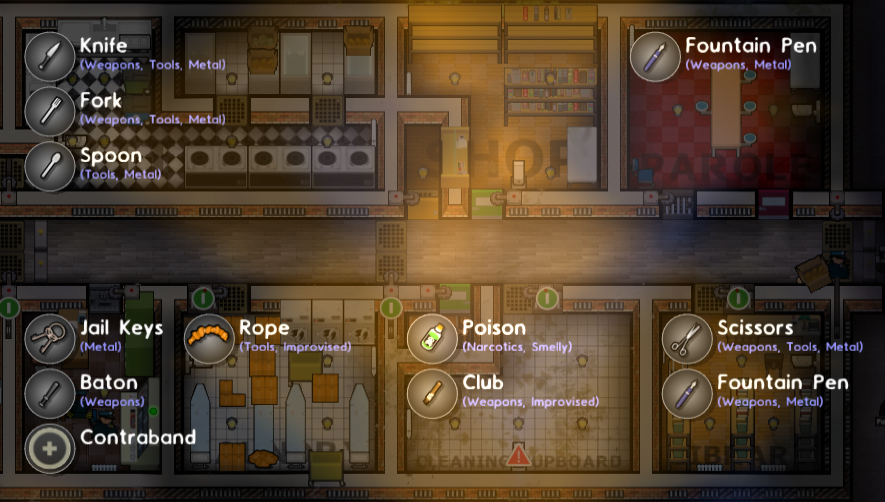
- Identify any weaknesses in reducing supply using “Dangers”. If you know that you do not have metal detectors for an area where metal contraband is available to prisoners, make efforts to change this. If you know that you do not have regular dog patrol for an area where other contraband is available to prisoners, consider how to position your dog patrol to maximise prisoners sniffed – also consider whether you have enough dog handlers and they have enough break time, and whether the kennel is close enough that dogs can quickly fill gaps in the patrols.

- Identify any weaknesses in reducing supply using “-24 Hours” and “-7 Days”. Some of the detection may be impossible to reduce without having 0 demand, particularly detection in the deliveries area. In general, the more detected on the prison wings rather than in other rooms in the prison, the worse you are doing in detecting contraband at the source from where it was stolen. This view can help you work out if your metal detectors and dog handlers are working and whether you need more.
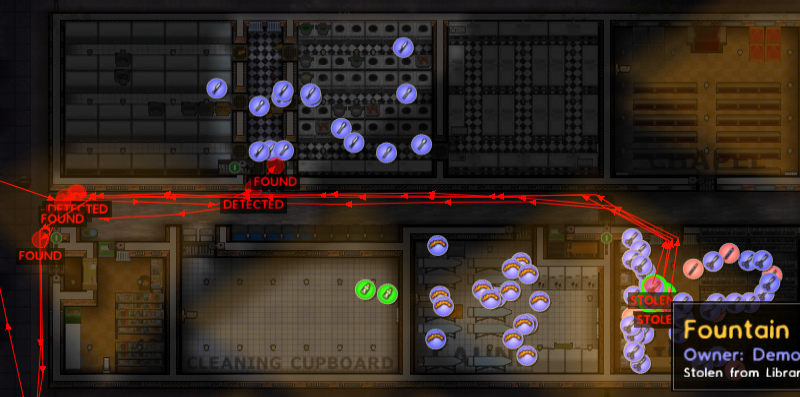
- Identify any weaknesses in reducing supply using “Stolen From”. Hover your mouse over this area to see what proportion of this contraband is making it to the prisoner wings rather than being detected and stopped early – you can then target interventions appropriately.
Using intelligence – informants
Informants, whilst not hugely helpful for your general contraband strategy, can be very useful to root out the last pieces of contraband. Informants will likely have a much better knowledge than you can possibly gain in other ways.
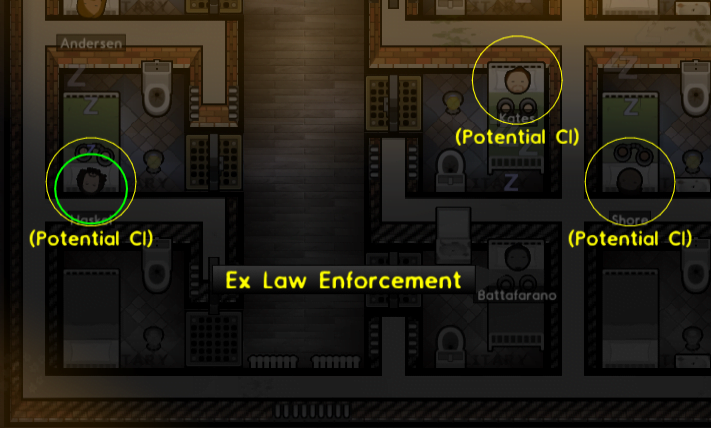
- Recruit confidential informants. To do this, find prisoners under duress (typically those in solitary confinement). If you do not have a solitary confinement unit, or you do not use it significantly, you may change this to start getting potential informants (who will have a yellow ring around them). Recruit them in their tab under “Experience”. You will have to do this fairly soon after they are brought into solitary confinement, as after a certain amount of time they will no longer want to be a confidential informant.
- Ensure that you have protective custody capacity in case things go wrong. If the suspicion on a confidential informant becomes high (particularly if information they provide has been used too much too quickly), they will be labelled as a “Snitch” and come under attack, so must be immediately put into a protective custody suite before they are attacked and killed.
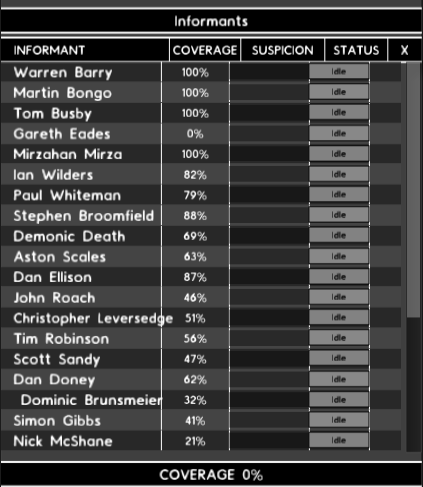
- Ensure that you have good coverage of confidential informants across your prison. Recruit as many as you can, which then allows you to use them sparingly and so reduce the suspicion they are placed under. The longer that they are a confidential informant, the more knowledge they will gain, making them more useful to you.
- Use to target prisoners specifically rather than having shakedowns (which prisoners do not like and which wastes a lot of guard time).
Searching prisoners
Searching a prisoner and any area of the prison may be initiated in a number of distinct ways, each with their own advantages and disadvantages. You should be aware of these and seriously consider all of your options – many architects rely solely on the first 2 options discussed here, whereas the other options should also be considered.
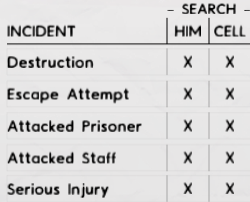
- “Policy” in “Reports” allows you to decide whether prisoners and / or their cells will be searched when they are caught for misconduct. In general, a prisoner should be personally searched after any misconduct, as most prisoners caught for misconduct will be carrying contraband (varying depending on how good your overall contraband strategy is). Deciding whether to search their cell is tricky, as unnecessary searches make prisoners angry and waste a lot of time for guards – adjust this for your prison on a trial-and-error basis, and responding in a Bayesian way to overall contraband supply (for example, if contraband is rife in your prison, the chances of you incidentally finding contraband in a cell are high, so you should search it; conversely, if contraband is rare in your prison, you are unlikely to find anything). Further to this, certain misconduct is more likely to be correlated with contraband, particularly: “Escape Attempt” (as prisoners often stockpile tools and laundry for this purpose); “Serious Injury” and “Murder” (though not just attacks, as prisoners who attack but without causing serious injury are unlikely to have used a weapon unless they have traits); “Found (anything)”.
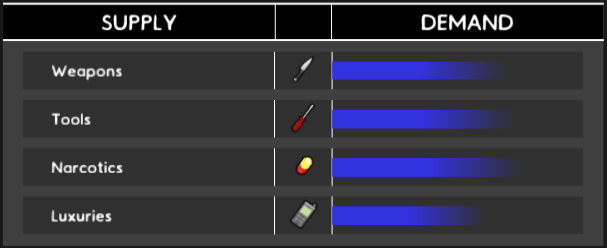
- “Shakedown” allows you to search every prisoner and every essential item in a given security category, multiple security categories, or the entire prison. Shakedowns are often a great way to root out most or even all contraband in a prison – the larger the prison, the less likely you are to find everything, but you should find most items. Shakedown may help you to achieve some grants, such as removing the supply of tools and weapons. Shakedown is also a blunt instrument that will leave a large proportion of your inmates unhappy at being unnecessarily searched – if you conduct even 1 shakedown, expect prisoner violence afterwards, multiple shakedowns in quick succession may lead to a riot! Your regular guards will be sapped away from other activities for hours during a shakedown, and with too few guards you may not ever be able to search the whole prison (making it less effective). With a prison with multiple security categories that do not mix, it is advisable to search each individually to avoid guard overworking.
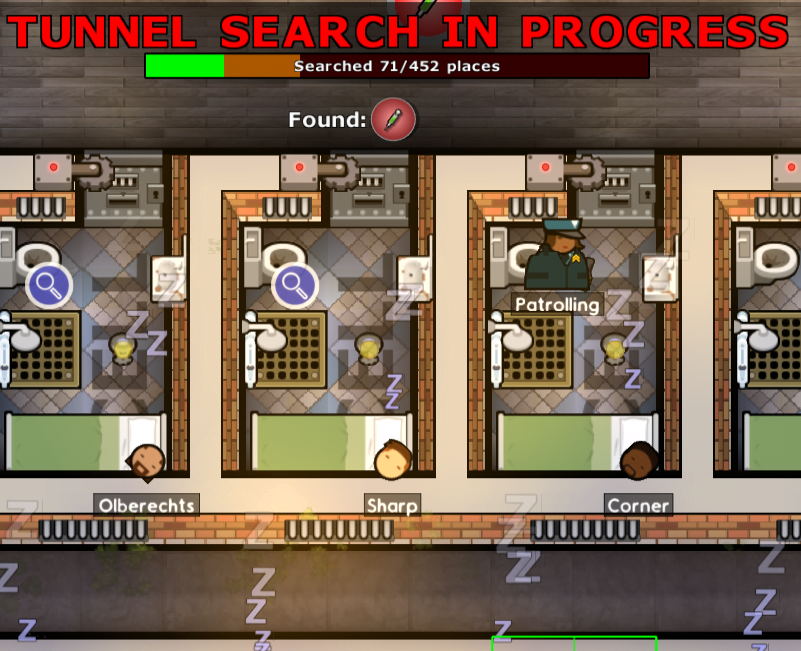
- “Tunnel Search”, whilst primarily designed to tackle tunnels by searching toilets in each cell, is also surprisingly powerful against contraband. Prisoners mainly get upset at unnecessary searching directed at their person, and will not be upset by mere toilet searches. However, the toilet is one of the most common places to stash contraband in the cell (less searched, prisoners not as upset, may detect contraband)
- Individual inmate and cell searches can be used to detect some contraband. It may be that you witness an inmate stealing contraband, in which case you can order that they be searched on the spot using their tab. Searching individual cells is unlikely to have any significant effect. If you search a whole block, then this can have the same general effect as a shakedown but only applied to parts of the prison to reduce overall inmate aggression.
Summary
- Reduce the demand for contraband by keeping inmates safe, giving them some freedom so they feel less like escaping, treating drug and alcohol addiction, and giving inmates access to recreation and the shop for luxuries.
- Reduce overall supply, focussing on using metal detectors and dog patrols to prevent contraband entry into the prison and onto the prison wings.
- Target measures against particular rooms, balancing risk and keeping inmates away from rooms you do not want them to enter. Ensure that your perimeter wall is secure and prisoners are kept far away from it.
- Use intelligence to target weaknesses in your existing strategy.
- Use intelligence to recruit informants who can help you to eliminate all contraband without having to mass-search prisoners.
- Search prisoners, including through policy, tunnel searches, block searches, and shakedowns. Use shakedowns when the incidence of contraband is high, but beware that prisoners will become angriest when searched unnecessarily.
